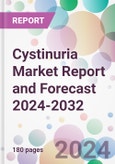Cystinuria Market Outlook
The cystinuria market size was valued at USD 106.45 million in 2023, driven by the increasing research to develop more effective and less invasive treatments for cystinuria in the major markets. The market size is anticipated to grow at a CAGR of 4.5% during the forecast period of 2024-2032 to achieve a value of USD 157.67 million by 2032.Cystinuria: Introduction
Cystinuria is a rare genetic disorder characterized by the excessive excretion of cystine, an amino acid, in the urine. This condition leads to the formation of cystine stones in the kidneys, bladder, or urinary tract. Symptoms include recurrent kidney stones, pain, and urinary tract infections. Cystinuria is caused by mutations in the genes responsible for transporting cystine in the kidneys. Management involves staying well-hydrated, dietary adjustments, and medications to reduce stone formation and relieve symptoms.Key Trends in the Cystinuria Market
There's ongoing research to develop more effective and less invasive treatments for cystinuria. This includes novel medications aimed at reducing cystine levels in the urine and improving the solubility of cystine to prevent stone formation. Additionally, advancements in minimally invasive surgical techniques for stone removal are improving patient outcomes.As cystinuria is a genetic disorder, there's a trend towards utilizing genetic testing to confirm diagnoses and inform treatment decisions. This approach facilitates personalized treatment plans, optimizing dietary and medication regimens based on individual genetic profiles and disease severity.
Increasing emphasis is being placed on patient education and the provision of dietary management tools. These resources aim to help individuals with cystinuria make informed dietary choices to minimize stone formation, enhancing the effectiveness of medical treatments.
The development of home monitoring solutions for urinary cystine levels allows for more frequent and convenient patient monitoring, aiding in timely treatment adjustments and better disease management.
Collaboration between research institutions, healthcare providers, and patient advocacy groups is fostering a comprehensive approach to understanding cystinuria and developing new treatments. These partnerships are crucial for driving research, raising awareness, and improving patient care and support.
Cystinuria Market Segmentation
Market Breakup by Disease Type
- Type I cystinuria
- Type II cystinuria
- Type III cystinuria
Market Breakup by Drug Type
- Tiopronin
- Penicillamine
- Others
Market Breakup by Dosage Form
- Solutions
- Tablet
- Injection
- Others
Market Breakup by Route of Administration
- Oral
- Intravenous
- Topical
- Others
Market Breakup by Distribution Channel
- Hospital Pharmacy
- Online Pharmacy
- Retail Pharmacy
Market Breakup by - 8MM
- United States
- EU-4 and the United Kingdom
- Germany
- France
- Italy
- Spain
- United Kingdom
- Japan
- China
Cystinuria Market Overview
In North America, the cystinuria market is shaped by advanced healthcare infrastructure and a high awareness of rare diseases. The region benefits from strong patient support networks and advocacy groups that promote research and access to care. There's a focus on genetic testing and personalized medicine to manage cystinuria effectively. Treatment approaches include nutritional guidance, medication, and, in some cases, surgical interventions. The U.S. and Canada also have specialized centers offering comprehensive care for patients with cystinuria.Europe's market is characterized by well-established healthcare systems and a strong focus on rare disease research and treatment. The European Union's policies on rare diseases encourage collaboration across member states, facilitating research, treatment development, and patient mobility for specialized care. There's an emphasis on early diagnosis through genetic screening and a multidisciplinary approach to treatment, including dietary management, pharmacotherapy, and advanced techniques for stone removal and prevention.
Japan's market for cystinuria is supported by a high standard of healthcare and a strong emphasis on innovation and precision medicine. The country has specific programs and policies in place to address rare diseases, providing support for research, development of new treatments, and patient care. Treatment approaches are comprehensive, focusing on dietary management, medication, and advanced technologies for stone detection and treatment. Patient awareness and education about cystinuria are also key components of the healthcare approach in Japan.
Cystinuria Market: Competitor Landscape
The key features of the market report include patent analysis, grants analysis, clinical trials analysis, funding and investment analysis, partnerships, and collaborations analysis by the leading key players.- Retrophin
- Recordati Rare Diseases
- Mission Therapeutics
- Enterome Bioscience
- Horizon Therapeutics
- Arcturus Therapeutics
- Codexis
- Mito pharmaceuticals
- Abbott
- Bausch Health Companies
- Allena Pharmaceuticals
- Mylan N.V. (now part of Viatris)
- Chiesi Farmaceutici S.p.A
This product will be delivered within 5-7 business days.
Table of Contents
1 Preface
3 Cystinuria Overview
4 Patient Profile
5 Cystinuria Epidemiology Analysis- 8 Major Markets
6 Cystinuria Market Overview - 8 Major Markets
7 Cystinuria Market Landscape - 8 Major Markets
8 Cystinuria Challenges and Unmet Needs
10 Cystinuria Market Dynamics
11 Cystinuria Market Segmentation - 8 Major Markets
12 United States Cystinuria Market
13 EU-4 and United Kingdom Cystinuria Market
14 Japan Cystinuria Market
15 China Cystinuria Market
16 Regulatory Framework
17 Patent Analysis
18 Grants Analysis
19 Clinical Trials Analysis
20 Funding and Investment Analysis
21 Partnership and Collaborations Analysis
22 Supplier Landscape
23 Cystinuria Market - Distribution Model (Additional Insight)
25 Company Competitiveness Analysis (Additional Insight)
26 Payment Methods (Additional Insight)
Companies Mentioned
- Retrophin
- Recordati Rare Diseases Inc.
- Mission Therapeutics
- Enterome Bioscience
- Horizon Therapeutics
- Arcturus Therapeutics
- Codexis
- Mito Pharmaceuticals
- Abbott
- Bausch Health Companies
- Allena Pharmaceuticals
- Mylan N.V. (now part of Viatris)
- Chiesi Farmaceutici S.p.A.
Methodology

LOADING...
Table Information
| Report Attribute | Details |
|---|---|
| No. of Pages | 180 |
| Published | February 2024 |
| Forecast Period | 2024 - 2032 |
| Estimated Market Value ( USD | $ 111.2 Million |
| Forecasted Market Value ( USD | $ 157.7 Million |
| Compound Annual Growth Rate | 4.5% |
| Regions Covered | Global |
| No. of Companies Mentioned | 13 |









